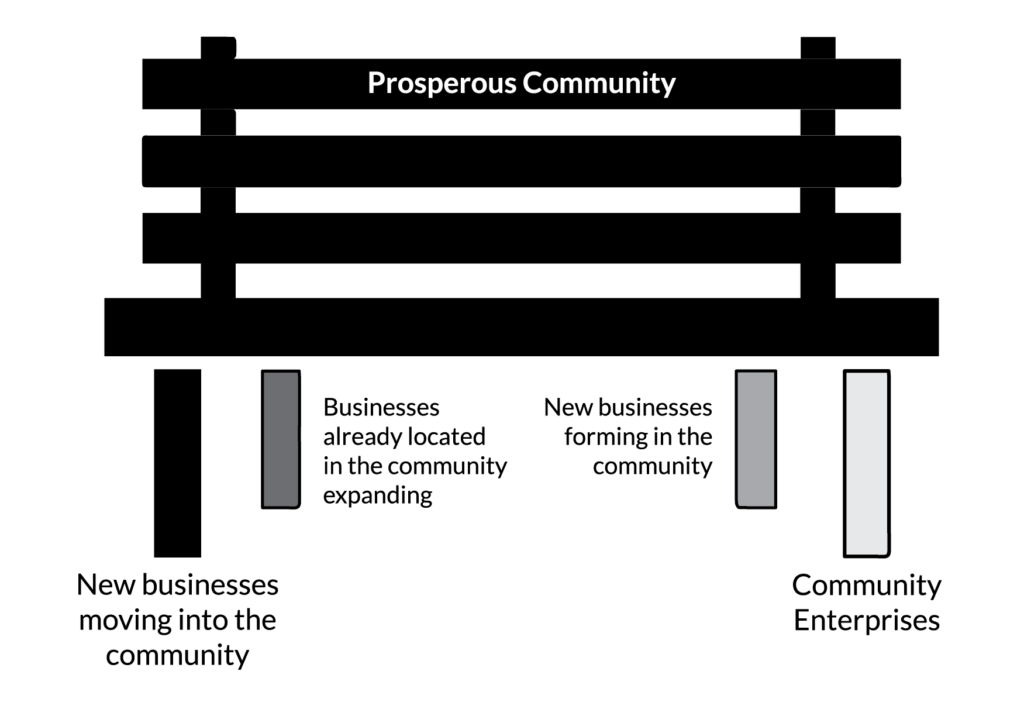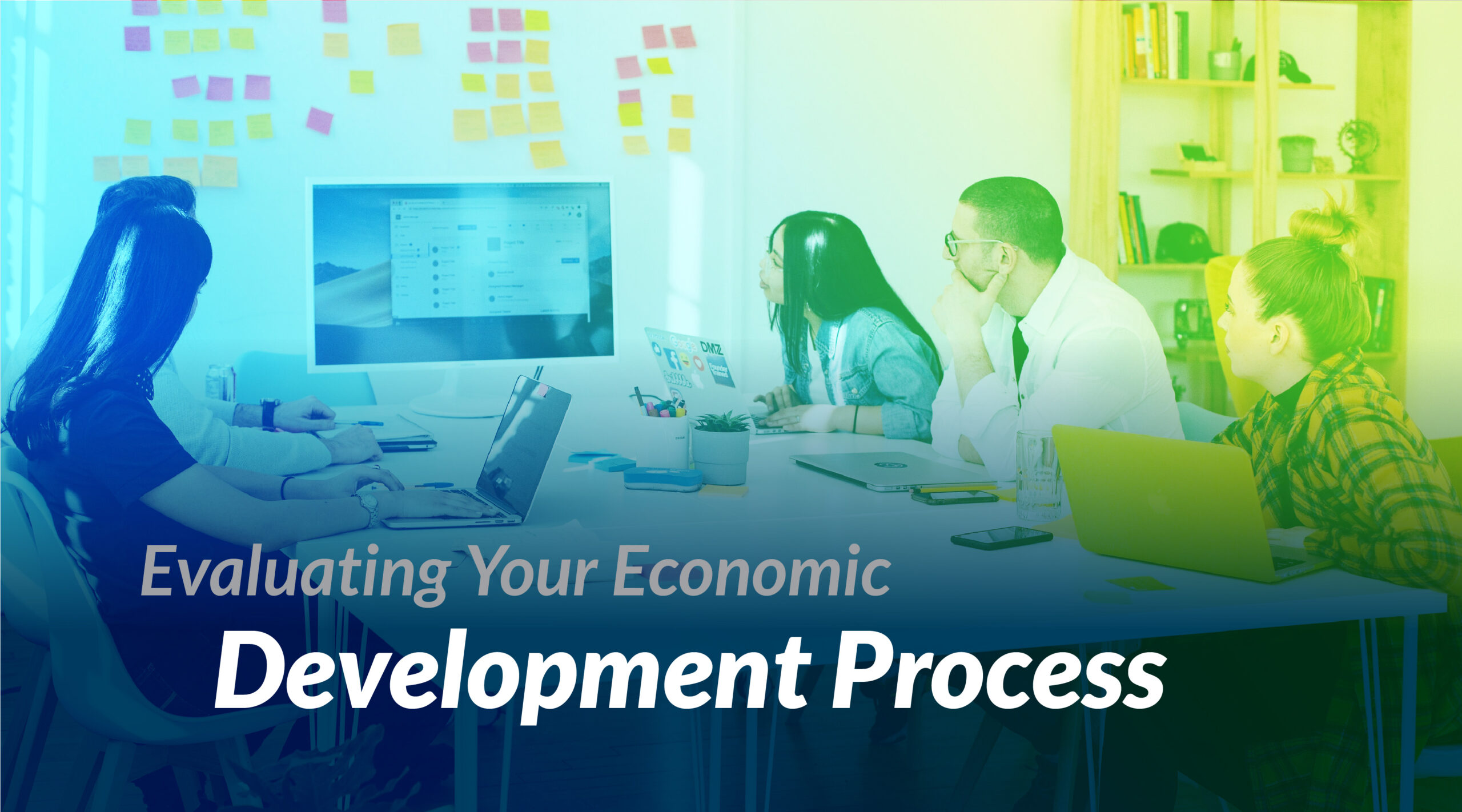Economic development is both an outcome and a process. The outcome is summarized in the blog for Worksheet 4.1: not just more jobs, but better jobs, and moving closer to the community’s vision for future development. And of course a key theme of the book is that a robust economy is a cornerstone of a prosperous community.
The process of economic development – how you build on a development-ready community to create a prosperous outcome – is discussed in Chapter 4 of Rebooting Local Economies in a variety of ways. The metaphor of a three-legged stool was used, with the three legs being recruitment of new industry, retention and expansion of existing industry, and facilitating new business start-ups. Given the discussion of community enterprises, we added that as another leg and our stool became a bench.

In the authors’ presentations, seminars and courses to economic development professionals we often ask a trick question: “How many community developers do we have in the room today?” Very few hands go up – by golly, we are economic developers! Next, we ask a series of questions such as “Who in the room has lobbied to pass a local bond issue to help with schools, roads or other community issues?” A few more hands go up. The next question might be “Who in the room has helped with workforce development in your community?” Even more hands go up. We keep this up until most of the hands in the room are up. Finally we ask “Why do you do these things?” and the response is “Because it makes our community better and helps us with our economic development responsibilities – attracting and retaining businesses.” At that point, we have achieved our “aha” moment (we might say to ourselves “bingo” but we don’t shout it). We have succeeded in demonstrating two key points:
- The proud professionals in the room are both economic developers and community developers, although when they entered the room they considered themselves only the former
- Community development and economic development are inextricably linked. A stronger community development process (to achieve the outcome of a development-ready community) usually leads to a stronger economic development outcome.
We tell this story as a reminder that the line between community and economic development is blurry, and rightfully so. In this tool, we are asking you to evaluate your economic development process – the delivery of economic development services. If you cross that blurry line and get into community development activities it will be a never-ending task because the list of community development activities – from building better infrastructure to improving education to providing better health care – is a long one. To further blur the line, as the story above illustrates, many economic development organizations also participate in community development activities.
Despite this interweaving of the community development and economic development processes, we are asking you to focus on the delivery of economic development services in this tool and worksheet. By this we mean activities directly related to creating more and better jobs and strengthening (maybe even rebooting!) the local economy. These activities can be classified into three categories: recruiting new businesses, retaining and expanding existing businesses, and facilitating new businesses. A fourth category, helping create community enterprises, can be added as well. This classification can be useful in inventorying and evaluating the economic development organizations and processes in your community.
Recruitment of new businesses: What organization is responsible for attracting investment into your community – promoting your community to businesses looking for a location of a new facility? There should generally be only one organization in a community that does this because it requires a significant commitment of resources, and communities need to speak with one voice when marketing themselves to outside investors. In many, if not most, communities (except larger multi-country metro areas) primary responsibility for recruiting lies with a county-level organization due in part to economies of scale. Communities within that county may have economic development offices or personnel who (hopefully) cooperate with the country-level recruiting organization. Many larger multi-county metro areas have a similar structure but on a larger scale, with one recruiting organization for the metro area with the counties and cities having supporting offices.
Business retention and expansion. In many communities, this may be the most important economic development role. Research has shown that in most communities, existing businesses and new start-up businesses create the majority of new jobs. Some businesses in a community sometimes need to expand or change location, and they evaluate their options – can the current community meet its expansion needs in terms of labor supply, available sites and buildings, etc. Sometimes, businesses may consider relocation because of “push factors” – overzealous regulations, problems with the labor supply, and many other reasons (see Chapter 16 “Retaining and Expanding Existing Community Businesses” in Introduction to Community Development, 2nd Edition, Routledge, 2015, for a deeper dive into this subject). Business retention and expansion involves, first and foremost, keeping up with the state of the local economy and the health of local businesses, and assisting where needed and possible with any problematic local issues such as regulations, labor supply, technical education and a host of factors. Most economic development agencies perform some kinds of business retention and expansion activities, whether formally or informally.
New business start-up assistance. Research has shown that direct or indirect assistance programs to help promising start-up businesses can help them succeed. Many communities, through their economic development agencies or related organizations, offer subsidized incubator space, revolving loans, business consulting and other services to start-ups. (See Chapter 17 “Entrepreneurship as a Community Development Strategy” in Introduction to Community Development, 2nd Edition, Routledge, 2015 for more information on making your community “entrepreneurial friendly” and assessing new business start-up activities).
Tourism: Even though the focus of the book does not include tourism promotion, tourists bring outside money into the local economy and spend it on lodging, dining, shopping, etc. And, according to the simple “money in/money out” model, more money flowing into the community contributes to wealth and prosperity.

As mentioned above, in most communities, one economic development organization usually has the lead role in the recruitment of new business. However, business retention and expansion and new business start-up assistance can be spread over many different organizations. Some of these programs are financed by the federal or state government loans or programs and may not even report to or coordinate with other organizations.
The first step in evaluating the economic development processes in your community is to compile an inventory of all economic development related organizations or offices. They can include:
- Separate economic development organizations (often structured as a public-private partnership)
- Chambers of Commerce
- Offices of economic development and/or personnel working for local governments in the community
- Offices or personnel involved in economic development in cities within a county or metro area.
- Downtown development authorities and the like
After the economic development organizations are identified, the next step is to evaluate their activities and make a determination of how effective and efficient they are. Where are the efforts from local organizations reinforcing each other and where are they overlapping and redundant? Obviously, this can be a sensitive subject due to local politics. Therefore, these kinds of evaluations are often performed as part of a strategic planning effort, and also often performed by consultants or other outside neutral parties. These outside experts are usually familiar with economic development services in other communities and can add to the usefulness of the evaluation by comparing a community to other communities.
Here is some useful information to collect on your community’s economic development organizations and efforts:
- Name of organization
- Chief contact
- Contact information
- Board members
- Years in operation
- Public or private?
- Representing or covering what geography?
- Funding?
- Economic development programs and functions (list specific activities under each category below)
- Recruitment of new businesses
- Business retention and expansion
- New business start-up activities
- Assisting with community enterprises
- Tourism promotion
- Other activities directly or indirectly related to 1-6.
From the inventory and evaluation, recommendations can and should be developed to improve the delivery of economic development services. As the Introduction to Rebooting Local Economies discusses, building a prosperous community is a job for all residents
The inventory and evaluation of the economic development processes in your community is not an easy process if done right, but it can make these processes and services much more efficient, providing more “bang for the buck.” Economic development is so important to a community that complacency and “turf wars” should not be permitted. A community should be a good steward of private and public resources devoted to building a prosperous community.
![2021 Prosperous Places Logo [TM]](https://www.prosperousplaces.org/wp-content/uploads/2021/02/20210205_JI_PPTM-Logo.png)



